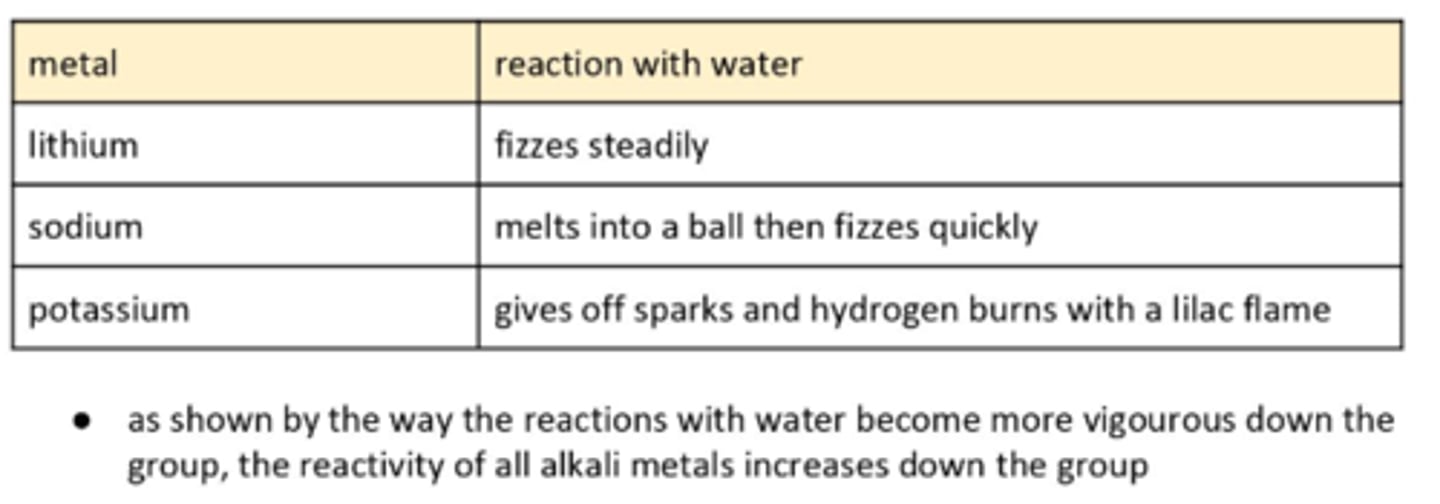Groups in the periodic table
1/18
There's no tags or description
Looks like no tags are added yet.
Name | Mastery | Learn | Test | Matching | Spaced |
|---|
No study sessions yet.
19 Terms
What are the properties of alkali metals?
Soft
Have relatively low melting points
Explain why some elements can be classified as alkali metals (group 1), halogens (group 7) or noble gases (group 0)
because they all have the same number of electrons in their outer shell so have the same chemical properties
Explain group 1's pattern in reactivity in terms of electronic configurations
In order to react, the elements in group 1 have to lose it's 1 valence electron. As you go down the group, the number of electron shells increases, distancing the valence electron from the nucleus, weakening the attraction between them. This is electron shielding and means that the electron can be lost more easily, making it more reactive. This is why reactivity increases as you go down the group
Describe the reactions of lithium, sodium and potassium with water
they all react vigorously with water to create an alkaline metal hydroxide + hydrogen
Desribe the pattern in reactivity of the alkali metals, lithium, sodium and potassium with water; and use this pattern to predict the reactivity of other metals

Colour and physical state of chlorine at room temp
yellow-green
gas
Colour and physical state of bromine at room temp
red-brown
liquid
Colour and physical state of iodine at room temp
grey-black
solid
pattern in the physical properties of halogens
melting and boiling points increase as you go down the group
due to increasing intermolecular forces as the atoms become larger, so more energy is required to overcome these forces
test for chlorine
damp blue litmus paper
turns red then bleaches
describe the reactions of halogens with metals to form metal halide salts
- the halogens decrease in reactivity moving down the group
- the rate of reaction is also slower further down the group
what happens when hydrogen and halogens react?
form hydrogen halides
e.g. hydrogen chloride
which dissolve in water to form acidic solutions
e.g. hydrochloric acid
describe reactivity of the halogens shown by their displacement reactions
occurs when a more reactive halogen displaces a less reactive halogen
e.g. chlorine displaces bromine so bromine becomes an atom and the solution turns orange (colour of bromine)
therefore chlorine is more reactive
from the pattern of reactivity with displacement, what can we predict about fluorine and astatine?
fluorine will displace all other halogens from their compounds (most reactive)
astatine will be displaced by all other halogens (least reactive)
describe halogen displacement reactions in terms of electrons
- A more reactive halogen can displace a less reactive in an aqueous solution of it's salt
- e.g. chlorine + potassium bromide --> potassium chloride + bromine
- Chlorine will displace bromine and iodine because it is more reactive
- bromine will displace iodine but not chlorine
iodine can displace neither chlorine nor iodine
explain the relative reactivity of the halogens in terms of electronic configurations
as you go down the group the reactivity decreases becuase the attraction between the valence shell and the nucleus decreases so it's harder to attract an 8th electron to have a full outer shell
why are the noble gases chemically inert?
They have a full outer shell of electrons
explain the uses of noble gases because of their properties
helium: filling balloons as it's less dense than air and non-flammable
argon: filament lamps as it's non flammable
pattern in the physical properties of some noble gases
melting point, boiling point, and density all increase as you go down group 0